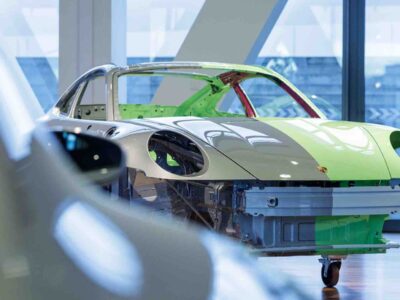Over the past decade, the trends in sustainable automotive have seen a greater focus on fuel efficiency, the emergence of the hybrid car, and now a growing presence of electric vehicles. Innovative companies like Tesla and Rivian are paving the way for the rest of the world in terms of what can be done with electric cars. However, the German engineering powerhouse, BMW, is making its presence known as the next forward-thinking automotive giant with its introduction of the BMW i Vision Circular concept car.
The car was presented to the 2021 IAA auto show as the BMW of 2040. The vehicle’s design focuses on sustainability while maintaining the brand’s hallmark of luxury. While this is not the first car BMW has released with sustainability in mind, it is certainly the most advanced. The car is constructed from 100% recycled or recyclable materials, taken from resources that have reached the end-of-life phase of its product life cycle, as well as making use of bio-based raw materials. The fully electric car boasts a recyclable solid-state battery manufactured almost entirely from recycled materials.
On top of the impressive sustainability specs, the car is beautiful. Piggybacking off of the design used in their flagship EV, the BMW i3, the futuristic hatchback looks to improve on their previous theme of melding luxury and sustainability. The sleek exterior is fashioned out of recycled aluminum treated with an anodized gold finish and the back panel makes use of heat-blued recycled steel to create the faded effect from bronze to blue. The windshield is made from recycled glass; the wheels and rims are made from “sustainable cultivated” rubber and recycled aluminum, respectively, with the colored rubber flecks added to the wheels for enhanced flair. These aesthetics highlight BMW’s choice to refrain from using paint, chrome, or anything that takes away from its sustainable-first ethos.
In order to maintain this high standard, a few of their trademark flourishes had to be reimagined. Instead of the blue and white insignia that adorns the front of their cars, they opted to laser engrave it, making the placement of the logo slightly more subtle. As for the grille, their famous double-kidney design now takes the form of a screen that also seamlessly integrates the lights on the front of the car.
In the interior, the design is just as gorgeous. The spacious interior is decorated with plush purple seats, and a beautiful dashboard made of 3D printed wood powder. As for the command center, the stunning crystalline piece on the center of the dashboard is made from 3D printed recycled plastic that “reacts to hand movements with an enthralling lighting effect.” Even at its most basic level, the car avoids environmentally caustic ways of bringing the vehicle together, like bonded connections and composites, and instead looks to more mechanical solutions like cords, press studs, and quick-release fasteners.
However, these thoughtful practices are not limited to the i Vision Circular. The BMW Group announced at the 2021 IAA show that they will also be looking to improve their sustainability standards across the whole organization. With the introduction of its Neue Klasse (New Class), it plans to bring its use of recycled materials up to 50% and decrease its emissions per kilometer by 50% as well. In addition, they introduced two new all-electric models, the BMW i4 and the BMW iX, to complement the existing EV BMW i3 and their high-performance hybrid sports car, the BMW i8, with four other electric models on the way. They will also look to put ten million all-electric vehicles on the road over the next ten years and double the delivery volume for their electric battery cells.
Dr. Andreas Wendt, Board Member for Purchasing and Supply at BMW, describes it best, saying that while everyone is producing electric vehicles, the way to stand out in terms of sustainability is not about the type of car, but the way it is produced, and this is best exemplified in their i Vision Circular concept car.
BMW thoughtfully designed this car not only as a way to decrease the impact the end-of-life stage of their products has on the environment, but to erase it entirely, breaking the mold on the harmful practices of car manufacturing and creating a more circular and regenerative way of producing cars. There is no doubt that in the coming years, BMW will be redefining what it means to be at the intersection between sustainability and luxury.





